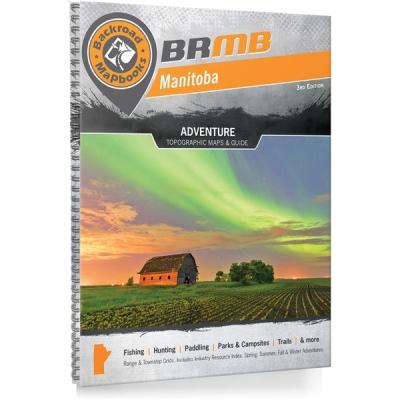
Backroad Mapbook Manitoba 3rd Edition
- Product Number: 657 - 391009
Enjoy Manitoba's four-season playgrounds and explore some of the country's most pristine back country. This Backroads Mapbook is the most updated version of the entire province of Manitoba!
The newly updated guide explores:
- Detailed back country road maps
- Backroad attractions
- Freshwater fishing areas
- Paddling routes
- National and Provincial Parks
- Trails
- Winter recreation
- Hunting information
Map Scale: 56 maps @ 1:250,000, 22 maps @ 1:500,000, 7 maps @ 1:1,000,000, 1 city map @ 1:80,000
Features
The Backroad Mapbook Series is the best selling Outdoor Recreation series in the country. The guidebooks provide up-to-date information with all the details needed to get you to outdoors safely and confidently.
Road Features
By combining city and rural roads with current forestry and logging road maps, backroads maps are designed for people wishing to get outdoors. A unique aspect of the maps is the fact they show the many side roads and backcountry routes that other maps do not. Whether you are looking for a park to visit close to home or are more interested in finding that seldom-visited lake to fish, these books leave no place uncovered.
Trail Systems
The Backroads maps highlight a wide variety of trail systems that range from popular hikes to a host of off-road routes. To aid users, trails are marked with symbols designating which type of user can access the trail wherever space allows. Another helpful feature is the fact that ATV, snowmobile trails and long distance trails are highlighted with a background colour to allow for easier navigation along the linear routes.
Paddling Routes
One of the most unique aspects of the Backroads maps is the fact that they show the various paddling opportunities in the area. Whether you are a canoeist looking to paddle a peaceful lake route, or a kayaker seeking the thrills and chills of whitewater, the maps provide the information you need to get out on the water. In addition to marking access points, maps note portages as well as the water route itself.
Parks and Recreational Areas
Most maps mark the provincial and national parks, but few mark those backcountry campsites that make Canada such a wonderful place to explore! On top of these, Backcountry maps also note natural areas, conservation areas and wilderness areas that few other map sources do.
Other Recreational Features
In addition to clearly marked trails and parks, you will also find a wide range of other recreational opportunities marked. These range from beaches to wildlife viewing opportunities. These features are labeled in green (for parks) or red (for recreation) and are usually accompanied by the appropriate recreational symbols.
Wildlife Management Units
Hunters and anglers will also be happy to see that Management Units are included on maps. The big green number notes the zones, while the boundaries are marked with a faint green border.
Elevation Relief Shading
The newest Backcountry maps have taken the concept of relief shading to a whole new level. On top of showing soft shadows and highlights to accentuate changes in the slope of the terrain (as if you were viewing the area from above), colours are also changed to match elevation. For the casual user, this adds a nice colouring that helps the readability of the maps. For the more experienced user, you can really study the subtlety of the land. (For those curious, the relief shading has been done as if the sunlight originates from the northwest).
Contour Lines and Labeling
The addition of contour lines has taken these guidebooks from simple travel guides to full blown topographical maps. When the contour lines are combined with the relief shading, it is very easy to see changes in slope of terrain, particularly in the mountains or prominent river valleys of the prairies. For the ‘mountainous' titles from the Rockies west, our contour intervals are 100 meters. Eastern users will find our contour intervals are only 30 meters.
GPS Compatible with UTM Grids
A useful navigational feature on Backcountry maps are the small numbers provided around map borders. These blue numbers represent UTM Grids and the black numbers represent Longitude and Latitude reference points. Although most GPS units are set to longitude and latitude, switching the unit to UTM (NAD 83) is both easier and more accurate for land-based travel. Since these maps provide UTM grid lines that are 10,000 metres (10 kilometres) apart (both east & north), users can accurately pinpoint the location of features by dividing the grid into 10 equal parts (both east & north). Counting the number of tics from the nearest coordinate value and multiplying by 1,000 will give you the UTM coordinate. Do this for both the Easting and the Northing and you will have an accurate GPS waypoint.
The Writing
In addition to the detailed maps, the researchers at Backcountry Maps have spent countless hours researching and writing about the various recreational opportunities in each area. Fishing, paddling, hiking, camping, wildlife viewing, snowmobiling, ATVing, skiing, biking, touring...you name it, they cover it! In addition to being grouped alphabetically by category, each listing is given a map coordinate so you can easily locate it. With thousands of listings in each book, we can safely say every book lists more recreational opportunities than you can possibly do in a lifetime (though we encourage you to try!)
Index and Map Key
No mapbook would be complete without an index and map key. An Index is provided at the back to help you find a specific area or site and the appropriate reference page or map coordinate. The map key is found at the back of the book and at the start of the maps and is designed to help you find a general area you want to explore. Individual write-ups on fishing, paddling routes, parks, trails, etc. can be found through the index or by searching the appropriate reference section.








